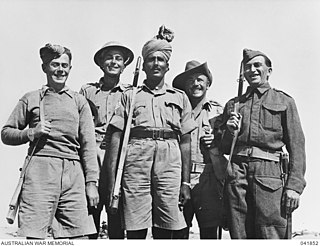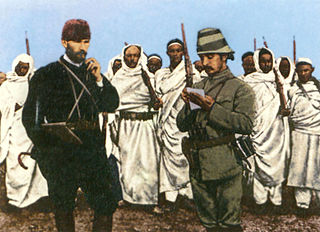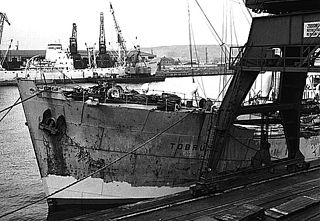
A defensive fighting position (DFP) is a type of earthwork constructed in a military context, generally large enough to accommodate anything from one soldier to a fire team.

Tobruk or Tobruck is a port city on Libya's eastern Mediterranean coast, near the border with Egypt. It is the capital of the Butnan District and has a population of 120,000.

Operation Crusader was a military operation of the Western Desert Campaign during the Second World War by the British Eighth Army against the Axis forces in North Africa commanded by Generalleutnant (Lieutenant-General) Erwin Rommel. The operation was intended to bypass Axis defences on the Egyptian–Libyan frontier, defeat the Axis armoured forces near Tobruk, raise the Siege of Tobruk and re-occupy Cyrenaica.

The siege of Tobruk took place between 10 April and 27 November 1941, during the Western Desert campaign (1940–1943) of the Second World War. An Allied force, consisting mostly of the 9th Australian Division, commanded by Lieutenant-General Leslie Morshead, was besieged in the North African port of Tobruk by German and Italian forces. The tenacious defenders quickly became known as the Rats of Tobruk. After 231 days, they were finally relieved by the British Eighth Army.

The Western Desert campaign took place in the deserts of Egypt and Libya and was the main theatre in the North African campaign of the Second World War. Military operations began in June 1940 with the Italian declaration of war and the Italian invasion of Egypt from Libya in September. Operation Compass, a five-day raid by the British in December 1940, was so successful that it led to the destruction of the Italian 10th Army over the following two months. Benito Mussolini sought help from Adolf Hitler, who sent a small German force to Tripoli under Directive 22. The Afrika Korps was formally under Italian command, as Italy was the main Axis power in the Mediterranean and North Africa.

The Battle of Gazala, also the Gazala Offensive was fought near the village of Gazala during the Western Desert Campaign of the Second World War, west of the port of Tobruk in Libya, from 26 May to 21 June 1942. Axis troops of the Panzerarmee Afrika consisting of German and Italian units fought the British Eighth Army composed mainly of British Commonwealth, Indian and Free French troops.

HMAS Tobruk (D37) was a Battle-class destroyer of the Royal Australian Navy (RAN). Built at the Cockatoo Island Dockyard, the destroyer was completed in 1950. Tobruk was deployed to the Korean War twice, and served with the Far East Strategic Reserve on three occasions during the late 1950s. In 1960, she was damaged beyond economical repair by sister ship HMAS Anzac during a gunnery exercise, which led to the destroyer's decommissioning that year, and sale for scrap in 1971.

Tobruk is a 1967 American drama war film directed by Arthur Hiller and starring Rock Hudson and George Peppard. The film was written by Leo Gordon and released through Universal Pictures.

The Rats of Tobruk Memorial is on Anzac Parade, the principal ceremonial and memorial avenue of Canberra, Australia.

HMAS Tobruk was a Landing Ship Heavy (LSH) of the Royal Australian Navy (RAN), based on the design of the Round Table-class of the British Royal Fleet Auxiliary. Planning for the ship began in the 1970s to provide the Australian Army with a permanent sealift capability. She was laid down by Carrington Slipways in 1979, launched in 1980, and commissioned in 1981. She was a multi-purpose, roll-on/roll-off heavy lift ship capable of transporting soldiers, APCs, and tanks, and delivering them to shore via landing craft or directly by beaching.

The Desert Rats is a 1953 American black-and-white war film from 20th Century Fox, produced by Robert L. Jacks, directed by Robert Wise, that stars Richard Burton, James Mason, and Robert Newton. The film's storyline concerns the Siege of Tobruk in 1941 North Africa during World War II.

The Battle of Tobruk (1911) or Nadura Hill Battle occurred on 22 December 1911 during the Italo-Turkish War. The battle was a small engagement primarily known for the involvement and leadership of future Turkish president Mustafa Kemal Atatürk.

The Rats of Tobruk were soldiers of the Australian-led Allied garrison that held the Libyan port of Tobruk against the Afrika Corps, during the Siege of Tobruk in World War II. The siege started on 11 April 1941 and was relieved on 10 December. The port continued to be held by the Allies until its surrender on 21 June 1942.
Tobruk International Airport is an airport serving the Mediterranean port city of Tobruk, capital of the Butnan District of Libya. The airport is 23 kilometres (14 mi) south of Tobruk, at the town of Al Adm.

Tobruk, subtitled "Tank Battles in North Africa 1942", is a board wargame published by Avalon Hill in 1975 that simulates tank combat in North Africa during World War II.
Al Andalus is a Libyan football club, currently playing in the Libyan Second Division.

Tobruk was a 7,090 GRT cargo ship which was built in 1941 as Empire Builder by William Gray & Company Ltd for the Ministry of War Transport (MoWT). On completion she was handed over to the Polish government-in-exile and renamed Tobruk. She was a member of a number of convoys during the Second World War. She was sold in 1951 to Polskie Linie Oceaniczne and served until 1967. She was scrapped in 1968.
The 2009–10 Libyan Cup was the 20th edition of the competition since its inception in 1976. Nasr secured their third title, defeating Madina 2–1 in a close final at the 11 June Stadium.

The Axis capture of Tobruk, also known as the Fall of Tobruk and the Second Battle of Tobruk was part of the Western Desert campaign in Libya during the Second World War. The battle was fought by the Panzerarmee Afrika, a German–Italian military force in North Africa which included the Afrika Korps, against the British Eighth Army which comprised contingents from Britain, India, South Africa and other Allied nations.
















